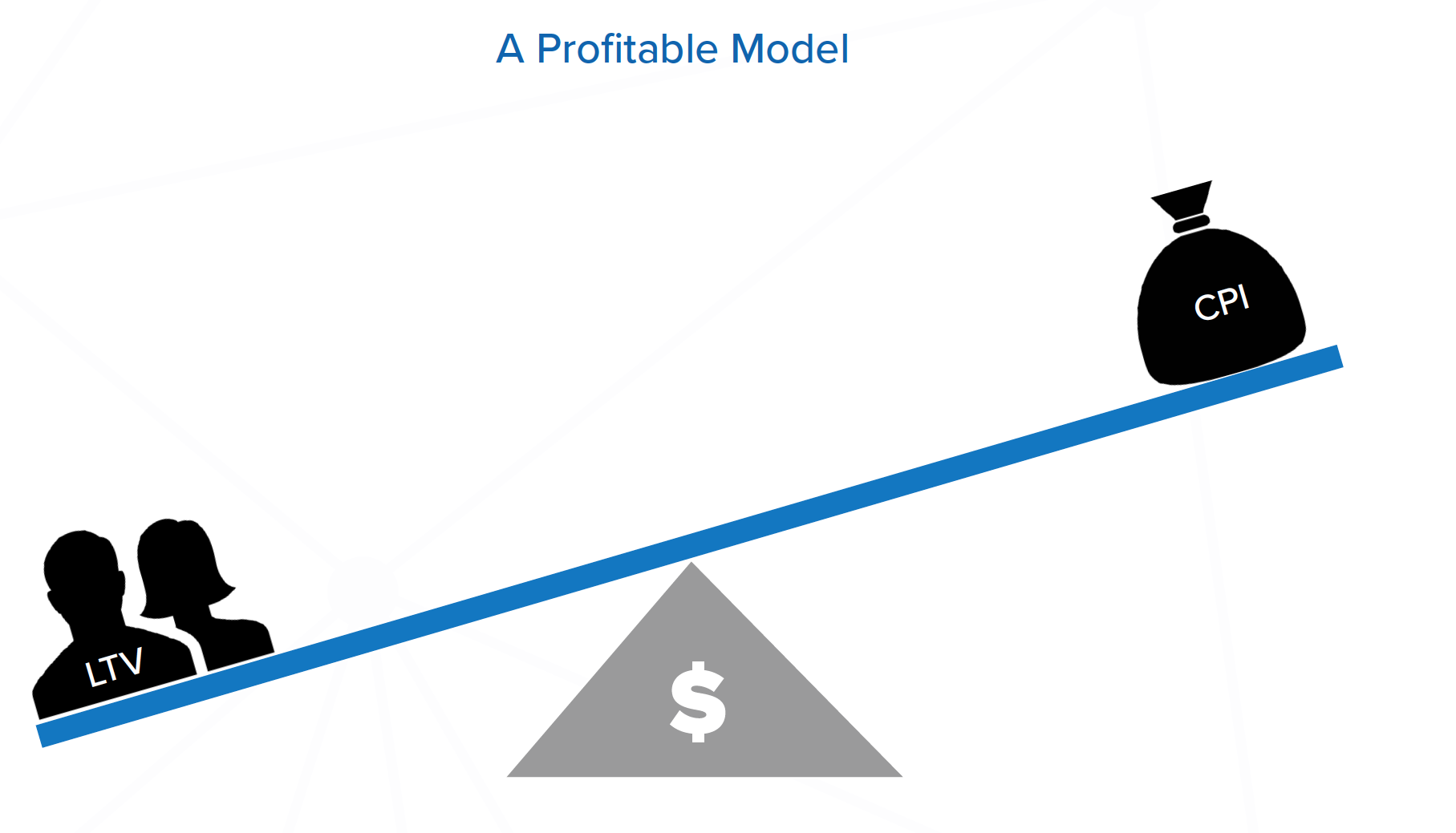How to Drive Mobile ROI Without Spending Millions on Acquisition

How much does it cost your company to acquire new users for your mobile app? And more importantly, is that cost worth the marketing budget you’re spending to get new users to install your app?
For the first question, there’s no right or wrong answer in absolute terms. Regardless of whether your cost per install (CPI) ends up being $1, $10, or even $100, you can’t know whether that’s good (i.e. profitable for your company) or bad (i.e. unprofitable) without also understanding your user’s lifetime value (LTV). As a metric, LTV tells you how much money each new user is spending in your app.
For the second question, anything other than a resounding “yes” can land you in hot water. If you’re spending more money on acquiring new users than those users are spending in your app, then you’re getting a negative return on investment.
The good news is that you don’t have to guess (or wonder) what your app’s ROI is—you can measure it precisely through some not-so-complicated calculations. And since anything that can be measured can be managed, the better news is that using the calculations we’ll go through below, you can boost your app’s ROI and increase your company’s profits. So let’s get started!
Figuring Out Your CPI and LTV
Your app’s ROI depends on your CPI and LTV. So first, we must understand these two numbers and determine what they currently are for your company.
Calculating Your CPI
To understand how much acquiring a new user truly costs your company, you can’t just look at the dollar amounts and metrics of an isolated ad campaign.
Instead, you need to take a more holistic view and calculate your entire marketing expenses over a certain period and then divide that number by the total number of new installations your app received during that same period.
CPI = Total Costs / # of Installs
Now you’ve got a number. Great!
Was the expense worth it? Let’s find your LTV to figure it out.
Calculating Your LTV
To calculate the lifetime value that each user brings in, you need to take an even wider look at your company numbers and find out the average amount of money each user spends in your app after installation and the average amount of time that each user remains active (and spending) in your app.
LTV = ARPU (Average Revenue per User) x customer lifetime
That’s going to give you a new number. Fantastic!
Now what? Now we compare the two numbers to see where you stand regarding ROI.
Positive or Negative ROI?
Getting a lot of installs can hide weaknesses in your product and in your path to positive ROI. As Spencer Skates, CEO of mobile analytics platform Amplitude, points out, “Companies overspend on marketing, without taking the time to recognize whether their gross increases in daily active users or downloads are actually turning a profit.”
For a positive ROI, you want your LTV to exceed your CPI. Put in simplistic terms, you want the number of dollars coming in from each customer to be greater than the number of dollars you dish out per customer.

If you’ve calculated your LTV of $6 and your CPI of $10, your ROI falls into the second equation—the negative one. That means that for every $10 you spend on getting a new user to your app, you’re only getting $6 back from that user. So you’re losing $4 per new user.
But if your calculations gave you the opposite numbers—so an LTV of $10 and a CPI of $6—then your ROI is positive. That means that for every $6 you’re spending getting a new user to install your app, you’re getting $10 back from that same user over the entire use of your app. So (roughly speaking) you have a $4 return on your investment. That’s $400 for every 100 new users.
How to Boost Your ROI
If your ROI is negative, you need to take action to increase it right away. But even if your ROI is positive you should still check if you can improve it to increase company revenue.
There are two main ways to boost ROI: you can either lower your CPI or increase your LTV.
Lowering Your CPI
Reducing your CPI means increasing your marketing efficiency. Audit your marketing strategies, tactics, channels, and methods to see how you can acquire customers at a lower cost. Some of the improvements you can make include:
- Converting the traffic you’re getting at a higher rate
- Getting more traffic to your app without increasing advertising costs
- Getting more qualified traffic to your app by targeting a better user avatar
- Increasing the organic shareability of your app
Increasing your LTV
Another way to improve your ROI equation is getting users to spend more money in your app after installation. Increasing ARPU doesn’t necessarily mean that you make your in-app purchases more expensive, or that you push more purchase options onto your users. The problem usually stems from your funnel and can be fixed by increasing your user retention rates. To improve your funnel you can:
- Use feature flags to test a variety of sign-up flows and discover which one improves your long-term user retention. A 6% increase in week one retention cascades into a 6% lift across the entire retention curve.
- Use a drag-and-drop visual editor to test variations of your checkout flow and increase conversions up to 15%. The visual editor allows you to narrow in on how many steps it takes customers to checkout, find the best copy to use, and know where to place calls-to-action without taxing your engineering resources.
Optimizing Your ROI
The truth is that your results will be a lot messier. That’s okay—they always are. The model above is just that: a model to help you get started with understanding the metrics that matter (namely, your CPI and LTV) for optimizing your mobile app marketing ROI.
The important takeaway to remember is that you don’t need to spend millions of dollars on a marketing budget, nor have millions of users flocking to your app to get a positive ROI. Instead, you simply need to monitor the right metrics, understand what those metrics mean, and know how to fix them.
Apptimize is the best-in-class mobile growth platform for Enterprise and SMBs, powering 1.2 billion app downloads across 75 countries.
Thanks for
reading!
More articles you might be interested in:
Mobile Dev without the App Store – A Closer Look at Facebook
Facebook had just about had it with the writers at TechCrunch. Each tiny little change they made was held under intense scrutiny on the front page of the blog. In the past month alone, TC had released a post about...
Read MoreHow Socialcam Got Millions of Users With Mobile A/B Testing
We recently sat down with Ammon Bartram, co-founder of Socialcam, a popular mobile social video app with 10’s of millions of downloads. Ammon tells us about how Socialcam optimized its flow and improved signup and engagement through mobile A/B testing....
Read MoreHow to A/B test on mobile without a single line of code
Since launching our Visual Apptimizer in January, we’ve been crunching away in our offices coming up with hot new features. The latest in a long line of exciting things to come is our zero line installation for iOS (we’re still...
Read More